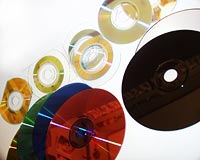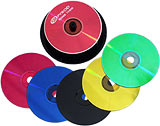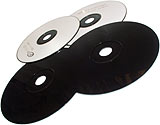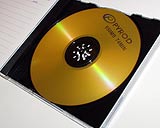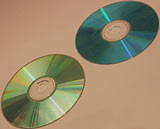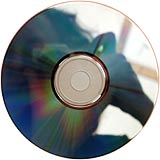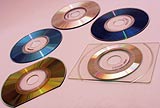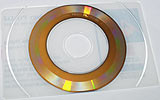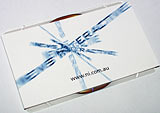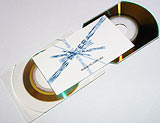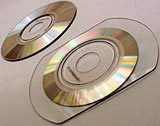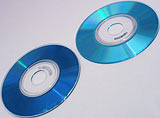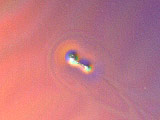
Oddball CD-R round-up!
Review date: 19 October 2000.Last modified 03-Dec-2011.
Black ones. Green ones. Yellow ones. Blue ones. Pink ones, for heaven's sake.
Little bitty ones. Even smaller oblong ones. 74 minute ones. 80 minute ones. 99 minute ones that hardly anybody can use.
Suddenly, buying CD-Rs has become complicated.
In the olden days, CD-Recordable media came in two basic flavours. There were brand name discs, that worked, and discs from funny unknown vendors that, well, often worked.
Cheap discs might be just fine in many writers and many readers, but they might be inherently incompatible with some other drives, and might also have quality control problems that meant that one disc in several was a lot less compatible than the others.
Add to that various differences in durability - some discs don't like getting wet, some don't like getting hot, some are more resistant to bending than others, some have a tougher top coating, some fall victim to atmospheric pollutants faster than others - and you could hardly blame people for buying name brand discs, even when they weren't making ten-year backups.
These days, you can get a ten-pack of big-name 74 minute CD-Rs, with jewel cases, for $AU30 or less. That buys you Kodaks, which many pros say are second to none in quality.
Now, you can get a spindle of 25 80 minute no-name no-case CD-Rs for little more, but either way it's not a fortune. Why bother with the cheapies?
Well, just look at this little lot. Tell me you don't find 'em interesting.
Funky colours
If you want to make a statement while maintaining full compatibility, coloured CD-Rs are for you. Pyrod sent me several samples.
When I first looked at the spindle of 74 minute discs they sent me, I thought "Oh! They're pink!"
Well yes, they are. The first disc I picked off the pile is a puce shade which should appeal marvellously to both the female cutesy-schoolgirl and male gladiator-movie-and-showtune-appreciator market segments.
But you also get blue, black, yellow and green. You get five discs of each type on the spindle. For a cheap-CD price - Pyrod don't quite have their on-line shopping site up yet and didn't give me any prices in advance, but these discs are competing with the low-cost crowd, not the premium brands.
These discs are not insipid pastel shades. The colour is solid and saturated and looks very swish indeed. The top of each disc is the same colour as the bottom.
They work just like ordinary CD-Rs, though. Under the pigment is normal cyanine dye - of which more later.
The black discs don't look like a real CD at all. They look like something that might come in a drive to protect it from shipping damage. The black pigment layer between you and the reflective layer means you don't get any of the rainbow diffraction effects you expect from a CD. The thing just looks like a mirror-finish piece of black plastic in the shape of a CD.
Pyrod have another variety of black CD - 80 minute, 700Mb discs. These ones have a white top side - you can't write on the black 74 minute discs unless you've got a pen with light-coloured opaque ink.
These CDs are fine if you just want something more fun than the usual silver, dark green, pale blue and gold CD-Rs, but they've also got some practical uses. Colour coding data according to type or sensitivity, for instance ("Johnson! What are you doing with a Black disc?! You know you've only got Pink clearance!"). Or making your promotional pack stand out from the crowd.
Disco discs
Sitting there in its jewel case, the Pyrod gold CD-R has the decency to look quite normal. And it only has normal 74 minute capacity. The back of the case goes on about its "newly developed reflective layer with greater hardness and higher reflectance", but this sounds no more revolutionary than the blurb on the back of practically every jewel case.
Look at the other side of the CD, though, and it's clear that there's something up. Pyrod CD lower left, yum cha CD-R upper right. Note the fancy-pants reflections on the Pyrod disc.
Here's a straight-on shot of a plain CD-R, demonstrating its ability to work as a passable mirror.
And here's the Pyrod disc.
If you're looking for something with which to cover the walls of your discotheque, these CDs would appear to be just the ticket. Whether the funny reflections indicate that these discs really are more readily read than other CD-Rs, I have no idea.
Leetle deescs
Pyrod sent me some CD singles and "business card CDs", as well, and I got some more of each kind from the rather cheekily named NaSa Technology (hey, somebody had to register nasa.com.au).
CD singles are 77 millimetres across, rather than 120mm, and work in many but not all drives. They're pretty much an orphan format, because they've only got 200Mb capacity (or 21 minutes of music) compared with the 650Mb of a plain 74 minute 120mm CD. But they cost more than even premium 120mm discs, because they're not made in anything like the same quantities.
77mm discs are neat little things, though. You can fit them in a pocket or a wallet or a brochure, so they're great for promotional purposes, or as emergency utility discs, or if you happen to be the hero in any of a number of recent movies in which information essential for the survival of the human race always seems to be on a 77mm CD.
They're also used by the very impressive Sony MVC-CD1000 digital camera, which I review here. Buy your 77mm CD-Rs straight from Sony and you'll pay a rather amusing $AU8 per disc. Buy them from someone else and they're $AU2 to $AU3 each.
Business card discs, though, are really peculiar.
NaSa stocks three flavours of business card CDs, two of them CD-Rs and one, the "E-Card", pre-stamped.
The curved-edge CD-R (top left) looks like a slice cut from a standard 77mm CD. Because data can only be stored in continuous circular tracks, only a circular area in the middle of the card can be used for storage. Despite that, it still manages 50 megabyte capacity. These discs cost $AU3 each if you only want a few, and the price drops to $AU2.40 each for quantities of a hundred or more. NaSa's price list is here.
The square-edge CD-R (top right) has a slightly smaller data storage area, for only 40Mb capacity. Its diagonal measurement's bigger than 77mm, but there's a ridge moulded into the bottom of the card that lets you locate it properly in any tray-load drive that can take CD singles. It costs a little more than the larger capacity, round-edge card-disc.
The E-Card (front) isn't a CD-R; it's a regular factory-duplicated CD, stamped with your choice of data and printed with your choice of graphics.
You only get 30Mb capacity on the E-Card - the sample card NaSa sent me has 28.7Mb of data on it - but that's still lots of room for Flash presentations or copies of your Web site or sample images or what have you.
The E-Card's got a true-rectangular form factor, with a curved moulded ridge part-way out to the edge, to allow it to engage the 77mm disc positioning ring in a tray-load CD-ROM drive.
It's 86mm by 56mm in size, which indeed does give it about the same footprint as a normal 2 by 3.5 inch US-type business card. A8-size business cards are smaller - 53 by 74mm.
A bit of the E-Card peeks out on the edges, a bit of the business card hangs over at the ends, but there's not much in it.
If you put stuff on an E-Card that you'd otherwise put on brochures and videos and such, it can end up a lot cheaper. In quantity, you can get E-Cards made up for you for as little as $AU3.50 each, but pricing depends on how many you want and printing costs as well. Aussie shoppers can e-mail NaSa for a quote and free sample.
Some other vendors, like CD Oz for example, offer stamped and printed rectangular "discs" for $AU2 or less each - but with minimum quantities of 1000 units, which may be rather more than you want.
Here are the two Pyrod card-CDs compared with a regular business card. Considerably wider, not much longer. You could fit them in a wallet with no trouble, and they come in plastic envelopes that'll protect them from harm.
Pyrod's business card discs look like a hybrid of the two kinds that NaSa stock - they've got the curved ends, but they don't have metal all the way out, just a ring of it in the middle of the card. They've got the same 50Mb capacity as the NaSa curved-end discs.
Even weirder
Rectangles aren't the end of it. You can make a CD any shape you like, as long as it isn't too big to fit where a 120mm disc would fit, or too small to fit where a 77mm disc would fit, or unbalanced.
Some "shaped CDs" aren't actually balanced at all - they're specifically made to be used as decorations, hanging from rear vision mirrors in those vehicles that can't make it all of the way over a speed bump without losing their W-shaped air dam and six inch exhaust tips.
Apparently, some people think hanging a CD in your window will defeat laser speed guns, or radar traps, or something. This works absolutely exactly as well as hanging a little sandbag from your rear vision mirror in order to repel small-arms fire.
There are various companies, like these people, for instance, that do shaped CDs to order.
You can only put data on uninterrupted circular tracks on a shaped CD. So if you've got a shamrock-shaped (but balanced) disc that's only got unbroken tracks for, say, half of its radius out from the centre, then you can only store data on those tracks. There's a metal layer all the way out to the tips of the leaves, but it can't be used for anything.
Something occurs to me. You could probably make a CD that whistled.
The circumference of a 120mm CD is about 377mm, and a 40X CD-ROM drive spins at more than 8000 revolutions per minute; this gives you a theoretical 50 metre per second (181 kilometre per hour) airflow at the edge, and not much less a few millimetres further in, where you could mould and/or cut a simple whistle-slot.
Of course, the CD pulls the air around with it in all sorts of complicated broken-Tesla turbine-esque ways, so your whistle note would be lower than you'd expect, and probably warble all over the place in annoying ways.
Out-standing.
But I digress.
The other kind of outlandish CD-R currently available is the "99 minute" disc, with more than 850Mb capacity. They're on the market now. You can only use these ultra-capacity discs to their full capacity with a few CD writers and software packages, though, and going much over the 80 minute mark means you're likely to be making a disc that only a select few can read.
There's also the "GD-ROM" ("Gigabyte Disc Read Only Memory") format, with a standard CD-ROM central area, a couple of millimetres of no data and then a higher density area that gives the disc a 1Gb capacity. It's used by the Sega Dreamcast game console, making the game discs impossible to copy with PC drives. The higher density part of the GD-ROM's inaccessible to CD-ROM readers and writers (GD-R discs exist, as well), but the CD-ROM part can be read as normal.
Compatibility
Glow-in-the-dark scratch-and-sniff CDs shaped like Pac-Man are all very well, of course, but not if they don't work in half of the world's CD-ROM drives. Some peculiar CDs are highly compatible. Some aren't.
77mm CDs work in just about every tray-load CD-ROM drive, CD writer and audio CD player. They also work in some slot-load drives, like the ones in current iMacs.
You can make a 77mm CD work in many other slot-load drives, caddy drives and so on if you click it into a 77mm-to-120mm adapter ring, yours for not much from any decent computer gear stockist.
77mm CDs do not work without an adapter ring in caddy or slot load drives that don't inherently understand 77mm discs. Sticking a 77mm disc into a slot-load drive that doesn't know what to do with it can result in the drive playing an impromptu Karlheinz Stockhausen concerto.
Business-card CDs behave more or less like CD singles, because none of them are big enough to touch the 120mm edge of a loading tray.
The ones that are shaped like a slice from the middle of a CD single, with round ends and straight sides, will work in a tray-load drive that takes CD singles, and can be clipped into a 120mm adapter ring like a regular single to work in pretty much any drive that understands plain singles in the same sort of adapter.
The rectangular CDs that really are rectangular, though, have a locating ridge moulded on their underside to engage the 77mm ring in a tray-load drive. You can't put these CDs in a 120mm adapter ring, unless it's a special one made for that particular flavour of rectangular CD.
No rectangular CD will work in any slot-load drive I know of, without a 120mm adapter. And, frankly, I'd be nervous about using one in a slot-load drive even with an adapter, given how annoying and expensive it'd be if the CD popped out of the ring inside the drive. Even proper singles in adapter rings make me nervous; baby CDs that don't clip as solidly into the adapter are tempting fate.
Practically every straight 120mm disc, with no cut-outs, will work in practically every current CD-ROM and DVD-ROM drive. Discs with unbalanced printing on them - something printed on one half of the top of the disc but not on the other half - can be sufficiently unbalanced to create 'orrible vibrations when modern high-speed drives try to spin them up. But that's about the limit of the compatibility problems you're likely to encounter. Red, green, black, yellow - no worries.
If you've got an old CD-ROM drive or CD burner, though, all bets are off. Older drives commonly have... issues... with CDs of particular formulations.
There are scads of different CD-R formulations out there, because every company that makes CD-Rs registers its own combination of ingredients that no other company's allowed to use. This means that new, different-looking formulations aren't necessarily better, they're just legally required to be different from anything that's been used before.
There are only two actual dyes used in CD-Rs - cyanine and phthalocyanine - but there are dye subvarieties, different kinds of reflective coating to put behind the dye, different top-side treatments, and so on. And this is before you start fooling around with purely cosmetic treatments.
Because of all this, the colour of a CD-R disc therefore hasn't got much to do with its performance. Different dye types have varying levels of compatibility with different drives, especially old or super-fast drives, but the dye alone doesn't make nearly as much contribution to the look of a CD-R, or indeed to its compatibility with different drives, as do all of the other factors.
All of the fancy cosmetic treatments are perfectly irrelevant - or should be. You'd think that black and blue and pink and polka-dotted discs would mean something to the read/write lasers, but they don't.
The lasers, you see, are infra-red (IR) - their wavelength is longer than that of the reddest light that humans can perceive.
This is why the laser assemblies on clamshell-type CD players have warning stickers telling you not to look at them. The laser power is so low that it poses much less risk to your vision than even the weedy one milliwatt laser diodes in cheap laser pointers. But because the light's IR, you can't see it, and there's no blink reflex.
You could, theoretically, stare at the thing for minutes on end while fiddling with the player and, perhaps, suffer retina damage.
The colour variations in old-style CD-Rs came only from interactions between the colour of the top of the CD and of the recording dye layer, which is translucent. Good old green-and-gold CD-Rs have a blue cyanine recording layer and gold ink on the top of the disc, which together give the bottom of the disc its green look. Discs with a silvery reflective layer and cyanine dye look blue.
Discs that use phthalocyanine dye can be any colour, because the phthalocyanine is practically invisible to anything that's not looking at the infra-red end of the spectrum.
Manufacturers of whimsically coloured CD-Rs, therefore, just have to colour them with dyes that aren't opaque to infra-red.
So it's conceivable that some readers and writers will have trouble with funny lookin' CDs, but not inherently because they're funny lookin'. Which brings us to the quality issue.
Quality
The big question, when you're shopping for budget CD-Rs, is whether the darn things are likely to work. The almost-as-big question is whether they're likely to still work after a year or so.
Some CDs are just badly made, or on the edge of tolerance for some writers, and manufacturers whose first priority is making their products appeal to Japanese schoolgirls are more likely to make these duds.
With CD burners that can whip along at 10X or 12X speed - or even faster, for the latest models - some of the old disc-and-burner compatibility problems are returning. 12X writing's pushing a hair over two megabytes of data onto the disc per second, and it's frankly amazing that it works on any disc.
It's hardly surprising that cheap over-capacity 80 minute discs, slightly off-centre cheaply stamped discs, and so on, don't work at these alarming speeds. Wind your burner back to 4X or 2X, though, and you ought to be able to write to just about anything.
Figuring out whether a given brand of disc is good or not is tricky. But it helps to know who actually makes it. It's often not the company whose name's on the label - even in the case of premium discs.
There's a lot of "badge engineering" in the CD-R market - companies making products for other companies to sell under their names. For instance, the most prolific maker of cheap and cheerful CDs, Ritek, is responsible for discs sold under the Arita, BASF, Dysan, FujiFilm, Hi-Space, Intenso, JTEC, Memorex, MegaData, MMore, Onkyo, Philips, Pony, Ricoh, Rimax, Samsung, Targa, TDK, Traxdata and Waitec & War names, if the CD Media World article here is to be believed.
Fortunately, there's a nifty little utility called CDR Identifier, yours for free from www.gum.de/cdrid, which has an excellent chance of telling you all about a CD-R. It reads the ATIP (Absolute Time In Pre-Groove) data that's stamped on every CD-R, and it has a big database of manufacturers and dye types. And it can read the disc capacity, too.
By using CDR Identifier, I determined that the NaSa curved-edge business card CDs - the 50Mb ones - and their pale blue 77mm discs (197Mb capacity) are made by Lead Data, a thoroughly unrenowned maker of off-brand cheapo-discs with, according to many accounts, less than optimal quality control.
You can clearly see the difference in the disc colour. The darker blue NaSa 77mm discs are from CMC Magnetics, another cheapo-maker that's also responsible for the not-particularly-good BASF brand media.
There's enough hate out there for CMC that I think it's fair to say their products actually are, definitely, dodgy. If you're looking for a weeny-disc, neither of the NaSa ones look like a great choice.
I wasn't totally impressed with the quality of the Pyrod 77mm discs I got, either, but only because one of them had this big fat (by CD standards) stamping defect on it. Click the image to see a wider shot showing the size of the defect.
The defect was on the top side of the disc, though; the writable side looked OK. So I filled the disc with MP3 files.
The write went fine, and almost all of the data was accessible afterwards - but I ended up with one munged file, which I presume was sitting on top of the defect.
Everything Pyrod sent me except their funky-reflection gold discs was made by Postech, a manufacturer about which I can't dig up much data. Which is not necessarily a bad thing at all.
Practically every CD-R maker, regardless of quality, will have someone out there that hates them, not necessarily with good reason. Hit deja.com and search for the manufacturer name and "quality" and you're likely to find testimonials, often negative, about all sorts of manufacturers. Find a lot of flames and you may have found a crummy brand.
Of course, testimonials are a very flaky way of finding out the truth about anything, but in the CD quality debate, they're often the best data available.
If you buy a stack of super-cheap Illuminated Dragonfly 80 minute discs from the Arthur Daley Perfectly Kosher 'Igh Tech PC Whatsits stand at the local computer market, and one out of two of them turns out to be good only for keeping coffee rings off the desktop, it doesn't take a degree in optical storage analysis to tell that you've not picked the world's best brand of CD-R.
But most discs, even cheapies, aren't obvious rubbish - well, most batches of them aren't, anyway. Without a battalion of new and old CD writers and CD-ROM drives, you can't tell what works with what with any degree of accuracy.
You'd think there'd be reliable quality surveys out there you could look at, but I've found precious few. Since all of the CD-R manufacturers keep bringing out new flavours of disc which are invariably, if you believe the press releases, capable of making whites whiter and colours brighter even as they save the whale, it's hard to find up-to-date information.
OK, so the GoldLock SuperStore discs they made last year weren't any good, but what about the UltraPlatinumPremium discs they're making now?
And then there's the durability issue. It's impossible to tell if a given CD-R will still be legible in ten years without costly environmental simulation gear, and even then there's a big difference between the typical domestic backup disc environment (in a jewel case, in the bottom of the sock drawer) and, say, a sunlit shelf in a seaside apartment.
It's all tremendously confusing.
But CDR Identifier helps.
It told me, for instance, that the NaSa square-edge business card CDs - the 40Mb ones - are made by Prodisc Technology, which may or may not be a quality manufacturer. I couldn't dig up any information on the subject. For what it's worth, Prodisc media are quite widely sold, but there don't seem to be many horror stories about them.
And the flashy Pyrod gold discs aren't a Postech product. They're made by Digital Storage Technology, another mystery-manufacturer with no track record I could find.
Christopher Lau, one of Pyrod's local staff, told me "we're selling CDs that compare in quality to the Mitsui's, at Princo prices" - which, if true, is a big plus. Mitsui make top-quality media, sold under the HP, Mitsui, Philips and Sony brands. Princo are, um, budget CD makers that sell discs under their own name, as well as making the internationally renowned BTC and KingTech brands.
Overall
If your data isn't particularly valuable - you're giving a pile of digital camera pictures to a friend, you're burning a compilation disc for the car, you're sending a slab of files to a desktop publishing output bureau that'll have finished the job in a few days - then the quality of the discs you choose isn't very important. Since discs that aren't obvious duds are only likely to fail in a few years time, there's no reason to use a "premium" disc for these purposes.
If you're making important backups, burning your band's new album to send to the mastering plant or taking mission-critical data overseas, though, crack open the wallet and drop another dollar per disc and you may save yourself a lot of pain.
When total quality is not your top priority, though, pink and black and twinkly discs certainly liven up one's day.
Realistically, business card CDs are not a very useful product. Their price per megabyte's ridiculously high compared with normal 120mm discs, and even compared with CD singles. You need to get a proper CD printer, or at least a labelling kit, to go with them if you want to use them as actual business cards - or you can get them duplicated and printed for you, but that pushes the price even higher.
There's some validity to business card discs as promotional items, but in any situation where you could hand someone a business card CD, you might as well give them a CD single instead - the round disc isn't just cheaper and higher in capacity, but it also won't cause their iMac to make coffee grinder noises.
But, nonetheless, the little things are Cool. It is impossible for any true technology appreciator to hold one without hearing faint strains of the James Bond theme in the background.
And now, I'm afraid I must be going. Gotta burn me some pink backups.
Postech's site
(maker of most of the Pyrod discs)
The Orange Forum
Web site
(the official source of information on CD-R and CD-RW)
The CD-Recordable
FAQ
(the best unofficial source of information CD-R and CD-RW)
CD Media World's CD-R quality survey
